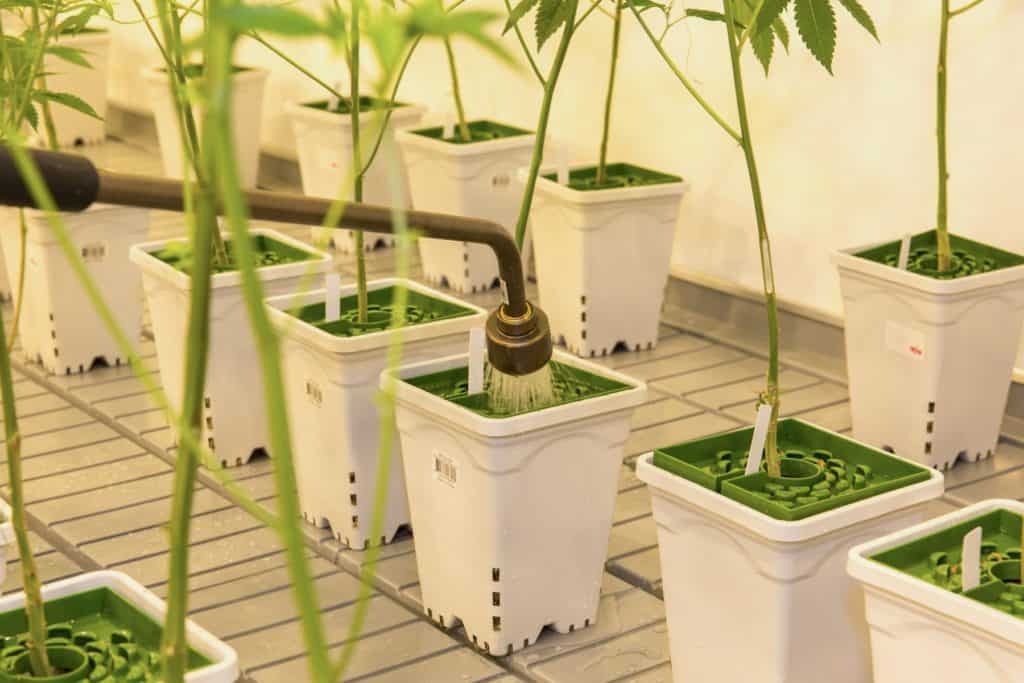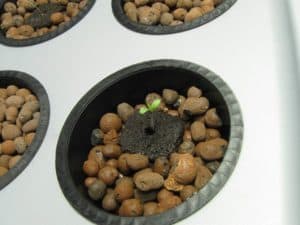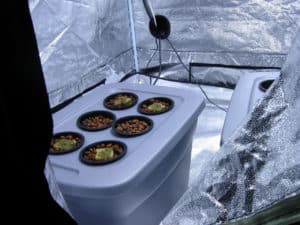
There’s been a lot of debate on whether or not using an RO system is the best choice for watering your cannabis plants, so we’re here to set the record straight. Some growers say that there’s not much point in using water that has undergone reverse osmosis, but we disagree.
Think of it as a way to start with a completely clean slate and know exactly what is contained within the water you’re feeding your plants.
Even if your home’s tap water is perfectly suitable, why settle for “perfectly suitable” when you could be using sparkling clean fresh RO water instead?
Would you like an ACMPR medical license to grow up to 500 plants at home?
What is Reverse Osmosis?
Similar to distillation, reverse osmosis is a process of purifying water. It’s often used in-home water filtration systems to remove impurities and produce fresher-tasting drinking water.
A reverse osmosis water system uses a partially permeable membrane to remove ions, unwanted molecules, and unnecessary particles from the water we (or our plants) drink.
If your home’s tap water contains a lot of dissolved salts, here’s what would happen. The reverse osmosis machine pushes the water through the membrane (think of it as a filter), but only pure H2O will be pushed through. The salts and other particles will be left behind.
What to Look for In a Reverse Osmosis System or Machine
As an ACMPR grower, you should be feeding your plants water that you would want to drink yourself. But the main difference is that a grow room full of plants needs way more water than a human drink can drink on a daily basis.
This is why you should steer clear from a water reverse osmosis machine that produces anything less than 100 GPD (gallons per day). You need a reverse osmosis system that can handle large quantities of water, especially for large grams-per-day licenses.
On top of that, you’ll want to think about the number of stages that a system uses to purify the water. The more stages (3, 4, or 5), the more filtration power. But a 5 stage reverse osmosis system is only necessary if your water contains tons of minerals and metals.
- Before you start growing, make sure you know all the regulations from Health Canada.
- If you haven’t got a grow license yet, check out our article on how best to get one.
- You might also be interested in our extensive guide to growing cannabis indoors.
Best Overall Reverse Osmosis System for Your Grow Room
The best overall reverse osmosis system for grow room will work to eliminate up to 99.99% of contaminants from your water. This includes everything from chlorine and fluoride to lead and arsenic. Chances are you’ll see a major difference when you feed your plants pure, fresh H2O.
Express Water Ultraviolet RO System
The Express Water RO System is as good as it gets when it comes to water purification. It uses 6 stages of filtration, and each of these filters lists out the impurities/contaminants removed. For example, the Activated Carbon Block removes “chlorine, insecticides, benzene, tastes, odors, and other organic chemicals.”
Even with 6 filtration stages, installation is pretty easy, and you should have no trouble doing it yourself. This system has a flow rate of 100 gallons per day, but you will still need a booster pump to keep up with the water needs of higher plant counts.
Best Reverse Osmosis Booster Pump (A Must Have)
A powerful booster pump will up the flow rate of an RO filtration system by increasing water pressure, so you’ll never have to worry about being short for your next plant watering.
Aquatec CDP 8800 High Flow Pressure Boost Pump
ACMPR growers with high plant counts know the struggle of having to wait around forever for the water tank to fill. But this is no longer an issue if you invest in the Aquatec CDP High-Flow Pressure Pump. This pump is compatible with both 100 and 200 GPD systems, so you can use it for just about every RO machine on this list.
Best Reverse Osmosis Machines for a Small Grow
Even the smallest reverse osmosis system can make a massive difference in the outcome of each harvest. Not all growers find it absolutely crucial to use a 5 or 6-stage system, which is where the AquaFX Barracuda comes into play.
AquaFX 610074278870 Barracuda
Traditionally used as an aquarium filter, the AquaFX Barracuda is the perfect small reverse osmosis system for low plant counts. The description says “your coral and fish will love you”, but in this case, go ahead and replace “coral and fish” with “cannabis plants”.
You’ve got the option for either a 50 GPD or 100 GPD, so choose carefully based on your allowed number of plants. The things we like most about the Barracuda are its quick-connect fittings and easy cartridge replacements.
Best Reverse Osmosis Systems for a Commercial or Industrial Sized Grow
A 50 or 100 GPD RO system just won’t cut it for massive grow ops. These days, lots of ACMPR growers are choosing to do things more efficiently by grouping 4 licenses under 1 roof – which is totally legal by the way.
This means that some medical grow ops in Canada contain thousands of plants. In this case, only a commercial reverse osmosis machine can get the job done.
iSpring RCS5T 500 GPD Tankless RO System
The iSpring RCS5T is an industrial reverse osmosis system that has an impressive flow rate of 500 gallons per day. That’s a lot of water. It may look like a fairly standard machine, but it’s capable of eliminating over 1,000 different pollutants as it filters.
Because of its high GPD rate, this is one reverse osmosis system that does NOT need a booster pump. It’s capable of providing pure water to the whole house, and better yet, the whole grow room.
Hydrologic 31023 1000-GPD Evolution
The Hydrologic 31023 is another commercial reverse osmosis water system that immediately caught our eye because of its 1,000 GPD flow rate. This is the next step up from the iSpring, but that also means it comes with a higher price tag.
For commercial-level growers, it’s worth it. You won’t need a booster pump, that’s for sure. Unfortunately, this one’s not as efficient as the iSpring; it produces about double the amount of wastewater.
Most Efficient Reverse Osmosis Systems
RO efficiency is measured not only by how quickly it can filter water but also by its waste to purified water ratio. The most efficient reverse osmosis system will have a 1:1 ratio for wastewater to purified water – like the Hydrologic Stealth.
HYDROLOGIC STEALTH RO System
The commercial Hydrologic RO system isn’t nearly as efficient as the company’s Stealth model. Although it will most likely need a booster pump for its 150/300 GPD, it has a much better waste to water ratio of 1:1. Even with its extreme efficiency, it can still remove up to 98% of contaminants.
Best Reverse Osmosis Machines on a Budget
So far, these RO machines have ranged drastically in price, but if you’re on the hunt for a reverse osmosis machine for cheap, there’s one product that takes the cake.
FS-TFC Under Sink Water Filter 5-Stage
The FS-TFC comes with 5 stages of filtration. It’s not only the best under sink reverse osmosis system, but also the best choice for growers on a budget. So many growers feel there’s no chance of watering with RO water when the budget’s a concern, but this isn’t the case with the FS-TFC.
This system has a flow rate of 100 GPD, so yes, you will need a booster pump. It can remove up to 99% of contaminants – up to 1,000 or them – and the wall-mounted design is easy to install. The manufacturer even throws in 4 extra filter replacements for free.
Get started on your medical grow license today!
Step 1: Enter your email to book your ACMPR license appointment today
- Compassionate Practitioners Required
- Help with Approvals
- Low Cost Renewals
- No Stress Appointments
Best Reverse Osmosis System for the Beginner
If reverse osmosis is still a new concept for you, you’ll want to go with a beginner-friendly system that isn’t too complicated. Your best bet is to choose a small grow room reverse osmosis system, like the Aquatic Life Twist-in.
Aquatic Life Twist-in 4-Stage RO Unit
This 4 stage reverse osmosis system is easy to use, easy to install, and filter replacements can be done in a matter of seconds. Even though this is great for beginners, it’s not lacking in any way in terms of filtration performance.
The 4 filters include a Sediment Filter, Carbon Filter, Membrane, and Deionization Filter. This is pretty much all you need for filtering out impurities – there’s no need to splurge on an advanced 6-stage system if this is your first time dealing with RO.
Why do you need reverse osmosis water for growing cannabis?
The main perk of using RO water you’ll have complete control of the water you use for growing. Water that goes through reverse osmosis is stripped clean of everything, mainly the things that your plants don’t like, but also things that they do.
This means that you’ll need to add nutrients back into the water, but the good news is that there’s no guessing when you start with water that contains absolutely nothing. If you want a quality grow from seed to flower, RO is the way to go.

How does an RO system work?
The process of purifying water through reverse osmosis system filters is actually very simple. Water pressure works to push tap water through a membrane, and as it’s pushed through, impurities and contaminants are removed.
Some of the most commonly found impurities in tap water include lead, fluoride, chlorine/chloramine, nitrates/sulfates, detergents, and pesticides. A high-quality reverse osmosis machine for home removes all of this and more – keeping your plants happy.
Does a reverse osmosis machine change the water pH?
Yes, and this is one reason that some ACMPR growers are skeptical about using reverse osmosis grow room system. As H2O goes through RO, its pH level is reduced (we can’t tell you exactly how much since it depends on the original chemistry of the water).
If your home’s water has a pH that is higher than 6.5-7, this is actually great. But if your home has an unusually low pH, it’s not ideal. However, pH Up and pH Down are two solutions that you should always have on hand, and these can easily help with any pH fluctuations.
How to Know if You Need RO Water for Your Grow
We’ll be honest with you, not everyone needs RO water for growing. But for the most part, investing in a reverse osmosis water machine will change your life. You want high quality water regardless of whether your plants grow in soil or in a soilless hydroponic system.
This is especially true for growers who are using a home water supply that contains impurities, which is the case for pretty much every municipal water source. Let’s face it, plants don’t want to be drinking chlorinated H2O or water that contains lead particles.
Even if your water has been deemed safe to drink, it may not be adequate for your plants – even Leafly says so. To know for sure whether a reverse osmosis water system is right for you, measure your water’s PPM.
PPM, or parts per million, is a measurement of the dissolved substances contained within your water. You can use a digital PPM pen for an exact measurement, and if it’s well above zero, reverse osmosis-ing is a good idea.

How do you install an RO system?
The exact steps for installation depend on the reverse osmosis machine you’ve purchased, but here’s a basic guide to getting it done with installation beneath a sink:
Step 1: Hang the filter assembly kit at the height that is specified in the user manual. Turn off hot and cold water shutoffs and install the tee/saddle valve that comes included with the unit.
Step 2: Cut the color-coded water supply line, making sure that it won’t get kinked. Fasten the included plastic tubing to the supply valve (refer to pictures in your manual, there should be some).
Step 3: Shorten the water supply/waste lines to minimize the amount of tubing. Just be sure not to cut the large black waste line yet.
Step 4: Attach the RO system lines to the fittings on the faucet base. The black waste lines feed through the base of the faucet to prevent sink backups, but they have no connection to the supply.
Step 5: Fasten the faucet to the sink, then install the drain line adapter under the sink basket. Cut the waste line so that it flows downhill with no loops, then push it into the adapter.
Step 6: Set the storage tank into place and install the final water line. Sterilize and fill the system according to the manufacturer’s instructions.
It may seem like a whirlwind of information right now, but it’ll make much more sense when you actually have the system in front of you. When in doubt, always refer to your user manual.
Conclusion
Here at CGC, our all-time favourite reverse osmosis system is the Express Water Ultraviolet RO System. Most buyers use this for home filtration and drinking water, but who says your plants can’t enjoy the same pure H2O that you would drink yourself?
Just be aware that using an RO system for a high volume filtration requires a booster pump. If you’ve got a 5-gram-per-day license, this isn’t so important, but for grow ops with hundreds of plants, a booster pump – like the Aquatec CDP 8800 – is necessary.

Reader Interactions